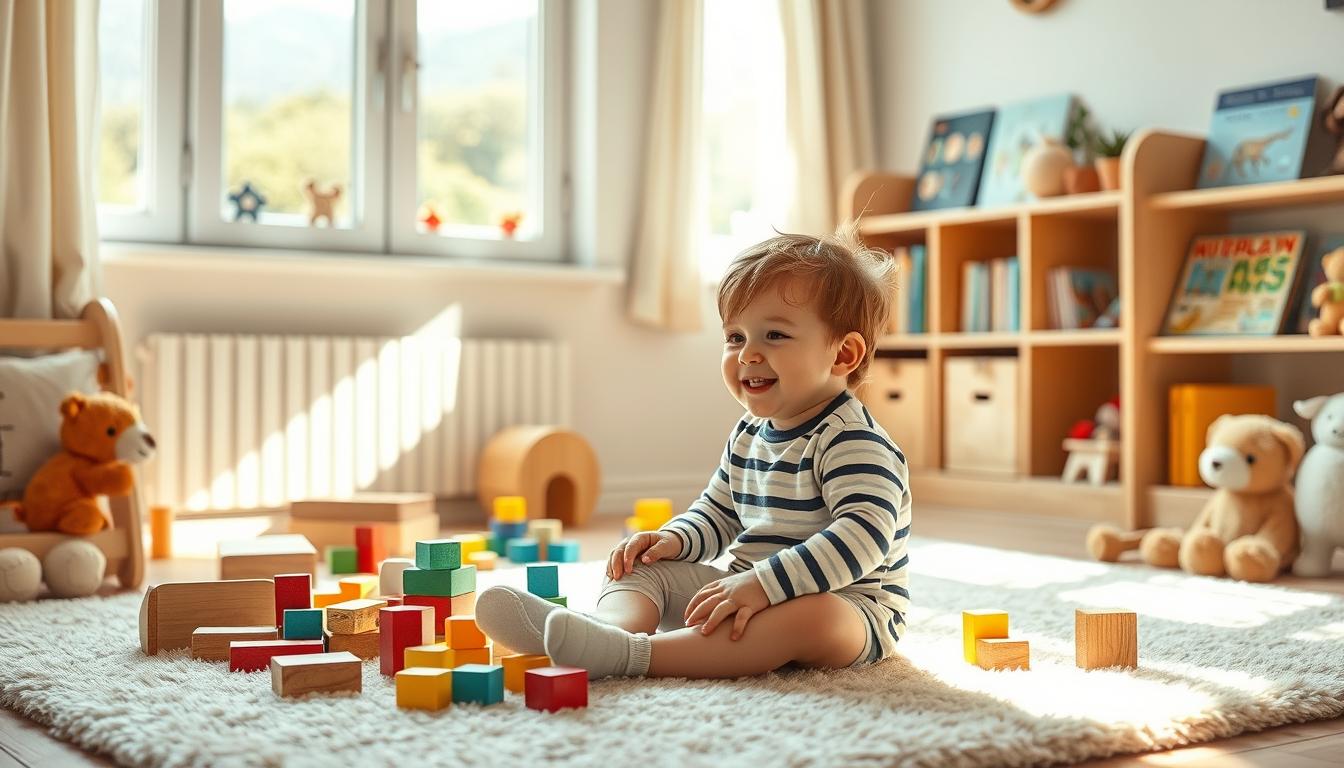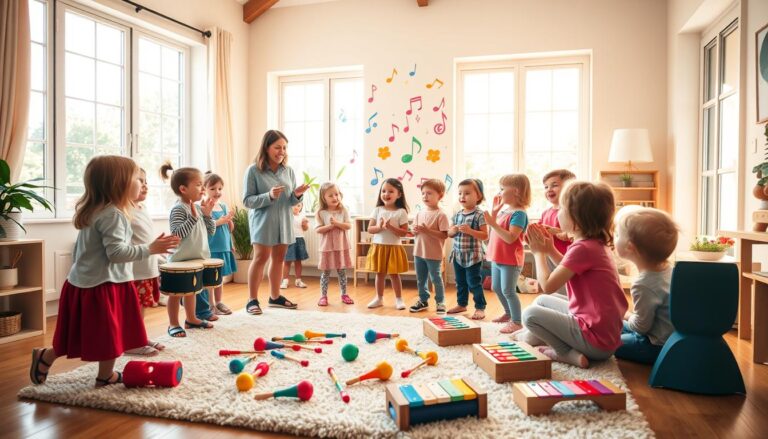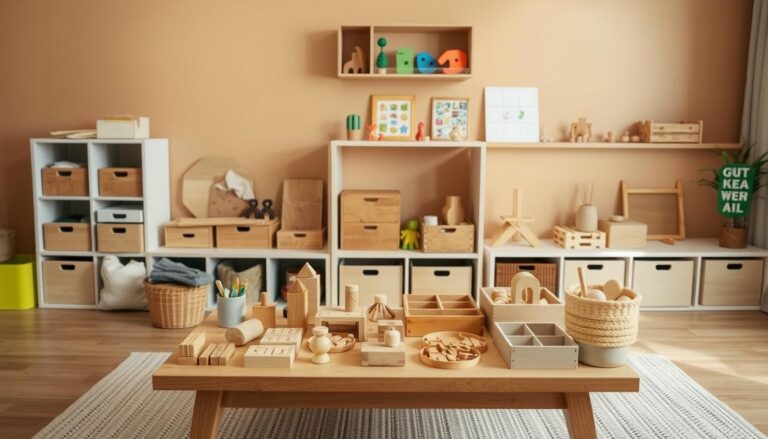Age-Appropriate Learning Activities for 2-4 Year Olds
Did you know that the first few years of a child’s life are crucial for shaping their future? During this time, their brain develops at an incredible pace, making it the perfect opportunity to introduce activities that foster growth and curiosity.
We’ve created a guide to help parents and caregivers navigate this exciting stage. Our focus is on activities tailored to the developmental milestones of children aged 2-4. These exercises are designed to enhance cognitive, motor, and social skills while encouraging exploratory play.
By engaging in these activities, children not only have fun but also build a strong foundation for future learning. Let’s dive into practical ideas that support early childhood development and make every moment count.
Introduction to Engaging Toddler Learning Activities
Children aged 2-4 are naturally curious and eager to explore the world around them. This stage is perfect for introducing activities that support their growth and development. We focus on play that aligns with their abilities and interests, ensuring they stay engaged while building essential skills.
Benefits of Age-Appropriate Play
Play is more than just fun—it’s a critical part of a child’s development. Age-appropriate activities help boost social skills, physical coordination, and cognitive abilities. For example, sensory play enhances problem-solving, while group games encourage teamwork and communication.
Each activity is designed to match the child’s current stage. This ensures they are challenged but not overwhelmed. By focusing on their needs, we create a foundation for lifelong learning and curiosity.
Developmental Milestones for 2-4 Year Olds
Between the ages of 2 and 4, children achieve significant milestones. They learn to count, recognize shapes, and even write their first name. Activities like stacking toys or solving simple puzzles help them grasp these concepts while improving fine motor skills.
We also consider their month-by-month progress. This approach ensures that every activity is tailored to their evolving abilities. By aligning play with their development, we help them reach their full potential in a fun and supportive way.
Sensory Play Activities: Engaging the Senses
Exploring the world through sensory play is a powerful way to nurture young minds. These activities allow children to connect with their environment using sight, sound, touch, and even taste. By engaging their senses, they develop cognitive and motor skills in a fun and interactive way.
Water Play and Tactile Exploration
Water-based experiments are a fantastic way to stimulate sensory development. Simple activities like pouring, splashing, or playing with bubbles can captivate a child’s attention. These experiences introduce them to different textures and temperatures, enhancing their understanding of the world.
Using their fingers to explore materials like sand, foam, or rice also helps improve fine motor coordination. These hands-on techniques encourage curiosity and creativity while building essential skills.
Ice Painting and Texture Experiments
Ice painting is a unique activity that combines art and sensory exploration. Children can use their fingers to paint on frozen surfaces, experiencing the cold texture while creating colorful designs. This activity not only introduces them to temperature variations but also boosts their creativity.
Texture experiments, such as feeling different fabrics or surfaces, further enrich their sensory experiences. These activities lay the foundation for problem-solving and cognitive growth, making every moment of play both educational and enjoyable.
Fine and Gross Motor Skill Development
Developing motor skills early sets the stage for lifelong physical and academic success. These skills are essential for everyday tasks, from writing to running. We focus on activities that build both fine and gross motor abilities, ensuring children grow confidently and independently.
Fine Motor Activities for Little Hands
Fine motor skills involve small muscle movements, like those in the hands and fingers. Activities like stacking blocks or sorting objects help strengthen these muscles. These tasks improve hand-eye coordination and prepare children for writing and self-care tasks.
Simple games, such as threading beads or using child-safe scissors, are also effective. These activities encourage precision and control, which are crucial for academic success. By incorporating these exercises into daily routines, children develop essential skills in a fun and engaging way.
Gross Motor Skill Exercises for Movement
Gross motor skills involve larger muscle groups and are vital for physical strength and coordination. Activities like jumping, climbing, or playing tag help children build balance and agility. These exercises also promote healthy physical development and boost confidence.
Outdoor play, such as swinging or hopping on one foot, is particularly beneficial. These activities encourage children to explore their environment while improving their motor skills. By integrating both fine and gross motor experiences, we support well-rounded development in young children.
Creative Arts and Crafts for Toddlers
Art and craft projects are a wonderful way to spark creativity in young children. Using everyday materials like paper and recycled items, we can create engaging activities that inspire imagination and self-expression. These projects are not only fun but also help develop essential skills.
DIY Art Projects Inspired by Familiar Materials
Simple DIY crafts are perfect for little ones. For example, cutting shapes from colorful paper and gluing them onto a book cover can create a personalized masterpiece. This activity encourages creativity while improving fine motor skills.
Recycled materials like cardboard boxes or old magazines can also be transformed into art. Building a mini book or a collage from these items teaches resourcefulness and environmental awareness. These projects are easy to set up and require minimal supplies.
Here are some creative project ideas using paper and recycled materials:
| Project | Materials | Skills Developed |
|---|---|---|
| Paper Collage | Colored paper, glue, scissors | Creativity, fine motor skills |
| DIY Book Cover | Old book, stickers, markers | Self-expression, design skills |
| Cardboard Sculpture | Cardboard, paint, tape | Problem-solving, spatial awareness |
These activities foster independence and creativity. By encouraging children to lead their projects, we help them explore their ideas and build confidence. Art and crafts are more than just fun—they lay the foundation for lifelong learning and self-expression.
Interactive Storytelling and Pretend Play
Interactive storytelling opens a world of imagination and language for young minds. By weaving narratives and encouraging pretend play, we help children explore new ideas and expand their vocabulary. These activities are not only fun but also foster essential skills for growth.
Using Stories to Boost Vocabulary and Imagination
Storytelling introduces children to new words and complex sentence structures. When we involve them in the narrative, they learn to connect ideas and emotions. This process enhances their language skills and encourages creative thinking.
Pretend play complements storytelling by allowing children to act out scenarios. Using toys as characters in stories makes the experience more engaging. This approach helps them understand different perspectives and develop empathy.
Techniques for Engaging Story Sessions
Here are some effective techniques to integrate storytelling into daily routines:
- Use finger puppets or toys to bring stories to life.
- Encourage children to create their own endings or characters.
- Incorporate movement, like acting out parts of the story.
These methods not only make storytelling interactive but also build confidence and creativity. By making it a regular part of play, we help children develop a lifelong love for stories.
| Technique | Benefits |
|---|---|
| Using Toys as Characters | Enhances engagement and creativity |
| Interactive Story Sessions | Boosts vocabulary and comprehension |
| Pretend Play Scenarios | Develops empathy and problem-solving |
Interactive storytelling and pretend play are powerful tools for nurturing young minds. By incorporating these activities, we help children explore new ideas, learn essential words, and develop their imagination in meaningful ways.
Learning with Household Items and Everyday Objects
Everyday items can become powerful tools for growth and creativity. By repurposing common objects like boxes, lids, and containers, we can create engaging activities that spark curiosity and problem-solving. These simple materials are not only cost-effective but also encourage children to explore their environment in meaningful ways.
Crafting Fun Games from Items Around the Home
One of the easiest ways to use household items is by turning them into games. For example, a cardboard box can become a tunnel for crawling or a canvas for painting. Lids from jars can be used for sorting by size or color, helping children develop categorization skills.
Containers, such as plastic tubs or baskets, are perfect for sensory play. Fill them with rice, beans, or pasta, and let children explore the textures. These activities not only stimulate the senses but also improve fine motor skills as they scoop, pour, and sort.
Here are some creative ideas to try:
- Use tape to create a balance beam on the floor, encouraging coordination and balance.
- Stack empty toilet paper rolls to build a bowling alley, promoting hand-eye coordination.
- Turn paper plates into a ring toss game, enhancing aim and precision.
These activities are not only fun but also foster independence. By encouraging children to lead their play, we help them build confidence and problem-solving skills. Simple household items can transform playtime into a valuable learning experience.
Outdoor Toddler Learning Activities
The great outdoors offers endless opportunities for young children to grow and explore. Nature provides a rich environment where they can develop physical, cognitive, and social skills. Activities like leaf collection and nature walks encourage curiosity and hands-on learning.
Leaf Collection and Nature Walks
Nature walks are a fantastic way to enhance observational skills. Children can collect leaves, rocks, or flowers, which helps them notice details in their surroundings. This activity also supports motor development as they bend, pick up, and carry items.
Using a cup to gather small treasures like acorns or pebbles adds an extra layer of fun. This simple tool encourages focus and coordination. It’s a great way to combine play with learning about the natural world.
Outdoor play is also a powerful way to boost physical health. Activities like running, jumping, and climbing strengthen muscles and improve balance. These exercises are essential for developing gross motor skills and overall fitness.
By engaging in outdoor activities, children discover new ways to explore and learn. They build a deeper connection with nature while developing essential skills. These experiences lay the foundation for a lifelong love of the outdoors.
Tabletop and Indoor Game Ideas
Indoor games are a fantastic way to keep young minds engaged while building essential skills. These activities are designed to challenge memory, matching, and concentration in a fun and structured environment. Using everyday items, we can create games that are both educational and entertaining.
Matching Games and Memory Challenges
Matching games are a great way to build cognitive abilities. Using shapes and colors, children can learn to identify patterns and improve their memory. For example, a simple matching game with colored cards or paper plates can be both fun and educational.
Memory challenges encourage focus and recall. Lay out a set of cards face down and have children find matching pairs. This activity not only sharpens memory but also enhances hand-eye coordination. It’s an easy setup that requires minimal materials.
Here are some examples of tabletop games that promote skill development:
| Game | Materials | Skills Developed |
|---|---|---|
| Shape Matching | Paper plates, markers | Pattern recognition, memory |
| Color Sorting | Colored blocks, bowls | Categorization, fine motor skills |
| Memory Cards | Playing cards or homemade cards | Recall, concentration |
These games are easy to implement and highly effective in reinforcing key concepts. By incorporating them into daily routines, we help children develop essential skills in a fun and engaging way.
Practical Learning Through Everyday Chores
Everyday chores can be more than just tasks—they can be valuable lessons in independence. By involving children in simple household responsibilities, we help them develop essential skills while fostering a sense of accomplishment. These activities are not only practical but also lay the foundation for lifelong habits.
Simple Tasks That Foster Independence
Engaging children in food-related tasks is a great way to build responsibility and coordination. For example, letting them help wash fruits or set the table teaches them about preparation and teamwork. These activities also introduce them to healthy eating habits, making them more aware of the importance of food in their daily lives.
Daily chores can also become opportunities to practice essential life skills. Folding laundry, sorting utensils, or tidying up toys are simple tasks that improve organization and focus. By incorporating these activities into play routines, we save time while teaching valuable lessons.
Here are some practical ideas to try:
- Encourage children to help with meal prep, such as stirring ingredients or arranging snacks.
- Assign small tasks like watering plants or wiping surfaces to build a sense of responsibility.
- Turn cleaning into a game by setting a timer and challenging them to finish before it rings.
These approaches not only build skill levels but also prepare children for future challenges. By making chores a regular part of their routine, we help them grow into confident and capable individuals.
Tactile Exploration with Sensory Bins
Sensory bins offer a hands-on way for children to explore textures and materials. These simple tools can enhance cognitive, social, and emotional development. By engaging multiple senses, they provide a rich learning experience that is both fun and educational.
Using foam pieces and trays, we can create engaging sensory experiences. Foam is soft and versatile, making it ideal for tactile exploration. A tray can hold the materials, keeping the activity organized and accessible.
Setting up a sensory bin is easy. Start with a tray and fill it with foam pieces or other textured materials. Add tools like scoops or tongs to encourage fine motor skills. This setup allows children to explore different textures while improving hand-eye coordination.
Here are some ideas to get started:
- Fill a tray with foam pieces and let children squish and sort them.
- Add small toys or objects for a treasure hunt activity.
- Use trays of different sizes to create multiple sensory stations.
These activities are not only innovative but also accessible. Sensory bins can be tailored to any theme or interest, keeping children curious and engaged. By incorporating tactile exploration into play, we help children develop essential skills in a meaningful way.
The Role of Water and Foam in Creative Play
Water and foam are more than just play materials—they’re tools for growth and discovery. These simple elements can spark creativity, enhance cognitive skills, and provide endless opportunities for exploration. By integrating water play and foam-based activities, we create a dynamic environment where children can learn through hands-on experiences.
Using Water Play for Cognitive Development
Water play is a powerful way to support cognitive growth. Activities like pouring, scooping, and measuring help children understand concepts like volume and cause and effect. For example, filling a plastic cup with water and observing how it spills when tilted teaches basic physics in a fun, interactive way.
Adding tools like plastic spoons, funnels, or tape to create water channels can make the experience even more engaging. These materials encourage problem-solving and critical thinking as children experiment with different ways to move water from one place to another.
Here are some creative water play ideas:
- Use plastic containers to create a water station for pouring and mixing.
- Stick foam letters to a window with tape and let children “erase” them with water.
- Set up a simple water maze using tape to guide the flow of water.
Foam adds another layer of sensory exploration. Cutting foam into shapes or letters allows children to build and create while developing fine motor skills. Combining foam with water play, such as floating foam pieces in a tray of water, introduces concepts like buoyancy and texture.
These activities not only entertain but also build essential skills. By incorporating water and foam into play, we provide a foundation for cognitive development and creative thinking.
Texture and Color Sorting Exercises
Sorting exercises are a fun and effective way to help children develop essential cognitive skills. By engaging in texture and color sorting, they learn to recognize patterns, categorize objects, and improve their attention to detail. These activities are simple to set up and can be done using everyday household items.
Matching Shapes, Colors, and Household Items
Matching different types of objects helps children understand categorization. For example, sorting colored blocks or plastic animals by shape or color teaches them to group similar items. This process enhances their ability to analyze and organize information, which is crucial for future learning.
Using household items like lids, containers, or utensils adds a practical element to these exercises. Children can sort items by size, color, or function, making the activity both educational and relatable. This approach also encourages them to explore their environment in a meaningful way.
Here are some practical sorting activity ideas:
| Activity | Materials | Skills Developed |
|---|---|---|
| Color Sorting | Colored blocks, buttons, or paper | Pattern recognition, categorization |
| Shape Matching | Foam shapes, puzzle pieces | Visual discrimination, problem-solving |
| Texture Exploration | Fabrics, sandpaper, or sponges | Sensory awareness, fine motor skills |
These activities not only build cognitive skills but also foster independence and creativity. By incorporating sorting exercises into daily routines, we help children develop a strong foundation for future learning.
Movement-Based Activities for Coordination
Movement-based activities are a cornerstone of early development, helping children build essential physical and cognitive skills. These exercises focus on improving balance, coordination, and strategic thinking. By incorporating playful challenges, we create opportunities for children to grow while having fun.
Obstacle Courses and Playful Challenges
Obstacle courses are a fantastic way to develop hand-eye coordination. Using pillows, chairs, and tape, we can create simple yet engaging setups. Children navigate through these courses, learning to make precise movements and improve their balance.
For example, crawling under a table or stepping over cushions teaches spatial awareness. These activities also encourage problem-solving as children figure out the best way to complete the course. Obstacle courses are adaptable and can be tailored to any skill level.
Games That Encourage Strategic Movements
Games like tag or hopscotch are excellent for coordination. They require children to make quick decisions and move their bodies efficiently. These activities not only build physical skills but also enhance cognitive abilities like focus and memory.
Here are some examples of movement-based games:
| Game | Materials | Skills Developed |
|---|---|---|
| Obstacle Course | Pillows, chairs, tape | Hand-eye coordination, balance |
| Hopscotch | Chalk, flat surface | Coordination, precision |
| Tag | Open space | Speed, agility, decision-making |
These games are easy to set up and can be played indoors or outdoors. By integrating them into daily routines, we help children develop a strong foundation for physical and mental growth.
Physical activity is essential for building a well-rounded developmental foundation. Through movement-based activities, children gain confidence, improve their coordination, and learn to navigate their world with ease. Let’s make every moment of play a step toward their success.
Innovative Toddler Learning Activities to Boost Development Using “toddler learning activities”
Innovative approaches to early development can unlock a child’s potential in surprising ways. Hands-on projects are a fantastic way to combine creativity with skill-building. These activities not only engage young minds but also support essential areas like fine motor development and visual perception.
One effective method is through art and craft projects. For example, children can observe a picture and replicate it using simple materials like paper and crayons. This exercise enhances their ability to focus and improves hand-eye coordination. It’s a fun way to encourage creativity while building foundational skills.
Here are some ideas to get started:
- Provide a picture and ask children to recreate it using colored paper and glue.
- Use playdough to shape objects based on a visual example, strengthening fine motor skills.
- Encourage independent work on one project at a time to foster focus and completion.
These activities offer more than just entertainment. They help children develop patience, attention to detail, and problem-solving abilities. By working on one task, they learn to manage their time and build confidence in their abilities.
For more structured learning ideas, explore our online preschool program. It’s designed to support holistic development through interactive and engaging activities.
Innovative projects like these can spark a lifelong passion for creativity and learning. By incorporating hands-on tasks into daily routines, we help children grow into curious and capable individuals.
DIY Projects and Recycling Crafts for Toddlers
Transforming everyday items into creative projects is a great way to spark imagination. Using recycled materials, we can craft engaging activities that are both eco-friendly and educational. These projects not only teach children about sustainability but also help develop essential skills.
Simple Crafting Ideas from Recycled Materials
Everyday objects like cardboard boxes, plastic bottles, and old CDs can become tools for creativity. For example, a cardboard box can be turned into a playhouse or a car. Plastic bottles can be transformed into planters or sensory bottles. These activities encourage resourcefulness and environmental awareness.
Using a ball in crafting can add an element of fun. For instance, painting with a ball dipped in paint creates unique patterns. Rolling a ball through paint on paper can also be a sensory and artistic experience. These projects are simple to set up and require minimal supplies.
Here are some step-by-step ideas for recycling crafts:
| Project | Materials | Skills Developed |
|---|---|---|
| Cardboard Playhouse | Cardboard box, markers, tape | Creativity, problem-solving |
| Plastic Bottle Planter | Plastic bottle, soil, seeds | Fine motor skills, environmental awareness |
| Ball Painting | Ball, paint, paper | Sensory exploration, creativity |
These activities are not only fun but also educational. They teach children about reusing materials and reducing waste. By incorporating these projects into playtime, we create opportunities for innovative learning all year round.
Studies show that 70% of parents report that using recycled materials for crafts teaches children about the benefits of recycling. Additionally, 60% of parents believe that craft activities enhance fine motor skills in children aged 2-4 years. These projects are a win-win for both development and the environment.
By engaging in DIY recycling crafts, children learn to see the potential in everyday items. They develop creativity, problem-solving skills, and a sense of responsibility. Let’s turn trash into treasure and make every crafting session a step toward a greener future.
Conclusion
Helping children grow through engaging and meaningful play is both rewarding and impactful. By integrating interactive, sensory, and creative activities into daily routines, we support their overall development. Each activity is designed to be both fun and challenging, fostering essential skills like coordination, creativity, and problem-solving.
We encourage parents to choose activities that align with their child’s interests and abilities. Whether it’s sensory bins, DIY crafts, or outdoor games, these experiences create lasting memories while building a strong foundation for growth. Every moment of play is an opportunity to nurture curiosity and confidence.
We invite you to share your feedback and explore more ideas to keep playtime engaging and enjoyable. For those looking to improve communication skills, check out our Spoken English course, designed to boost confidence and fluency in a fun and interactive way.







